Welcome!
Basically, it seems like you're working in a coordinate reference system not appropriate for the steps you execute.
library(raster)
GUA <- shapefile("Guam3BufferPoly.shp")
crs(GUA)
#> Coordinate Reference System:
#> Deprecated Proj.4 representation: +proj=longlat +datum=WGS84 +no_defs
#> WKT2 2019 representation:
#> GEOGCRS["GCS_unknown",
#> DATUM["World Geodetic System 1984",
#> ELLIPSOID["WGS 84",6378137,298.257223563,
#> LENGTHUNIT["metre",1]],
#> ID["EPSG",6326]],
#> PRIMEM["Greenwich",0,
#> ANGLEUNIT["Degree",0.0174532925199433]],
#> CS[ellipsoidal,2],
#> AXIS["longitude",east,
#> ORDER[1],
#> ANGLEUNIT["Degree",0.0174532925199433]],
#> AXIS["latitude",north,
#> ORDER[2],
#> ANGLEUNIT["Degree",0.0174532925199433]]]
Seems like the crs provided Guam3BufferPoly.prj is not quite up to standard, but I'm not 100 % sure here. However, you're working with lat/lon coordinates on WGS 84. Hence, spTransform(GUA, projGUA) has absolutely no effect, since you're reprojecting your feature to the same crs again.
This leads to a follow-up issue: You're working in degrees as units and specify a raster of 500 units (here: degrees, not meters, as probably intended). And this is exactly what raster() does, even if it makes no sense:
ext <- extent(GUA)
ext
#> class : Extent
#> xmin : 144.5962
#> xmax : 145
#> ymin : 13.19925
#> ymax : 13.70405
r <- raster(ext, res = 500)
r
#> class : RasterLayer
#> dimensions : 1, 1, 1 (nrow, ncol, ncell)
#> resolution : 500, 500 (x, y)
#> extent : 144.5962, 644.5962, -486.2959, 13.70405 (xmin, xmax, ymin, ymax)
#> crs : NA
To solve this, you should use a projected coordinate reference system suitable for Guam. Not sure how good of a fit this is, you'll probably know better, but let me try WGS 84 / UTM 55 S (EPSG: 32755):
putm <- spTransform(GUA, CRS("+proj=utm +zone=55 +south +datum=WGS84 +units=m +no_defs"))
ext <- extent(putm)
ext
#> class : Extent
#> xmin : 239608.8
#> xmax : 283618.4
#> ymin : 11460271
#> ymax : 11516045
r <- raster(ext, res = 500)
r
#> class : RasterLayer
#> dimensions : 112, 88, 9856 (nrow, ncol, ncell)
#> resolution : 500, 500 (x, y)
#> extent : 239608.8, 283608.8, 11460045, 11516045 (xmin, xmax, ymin, ymax)
#> crs : NA
r2 <- rasterize(putm, r)
pts <- rasterToPoints(r2, spatial = TRUE)
pts_lonlat <- spTransform(pts, "+proj=longlat +datum=WGS84")
plot(pts_lonlat, pch='*')

Edit:
You can simplify the process using sf instead of raster and sp IMHO. Individual steps include data import, reprojection to a metric crs, grid creation covering the whole extent of your dataset and "spatial filtering" by intersecting your buffer with the grid centroids.
library(sf)
sf <- st_read("Guam3BufferPoly.shp", crs = "epsg:4326") |> st_transform("epsg:32755")
#> Reading layer `Guam3BufferPoly' from data source
#> `Guam3BufferPoly.shp' using driver `ESRI Shapefile'
#> Simple feature collection with 1 feature and 1 field
#> Geometry type: POLYGON
#> Dimension: XY
#> Bounding box: xmin: 144.5962 ymin: 13.19925 xmax: 145 ymax: 13.70405
#> Geodetic CRS: WGS 84
grid <- st_make_grid(sf, cellsize = 500, what = "centers") |> st_intersection(x = sf, y = _)
grid
#> Simple feature collection with 3839 features and 1 field
#> Geometry type: POINT
#> Dimension: XY
#> Bounding box: xmin: 239858.8 ymin: 11460520 xmax: 283358.8 ymax: 11516020
#> Projected CRS: WGS 84 / UTM zone 55S
#> First 10 features:
#> ID geometry
#> 1 1 POINT (246358.8 11460521)
#> 1.1 1 POINT (246858.8 11460521)
#> 1.2 1 POINT (247358.8 11460521)
#> 1.3 1 POINT (247858.8 11460521)
#> 1.4 1 POINT (248358.8 11460521)
#> 1.5 1 POINT (248858.8 11460521)
#> 1.6 1 POINT (249358.8 11460521)
#> 1.7 1 POINT (249858.8 11460521)
#> 1.8 1 POINT (250358.8 11460521)
#> 1.9 1 POINT (250858.8 11460521)
Created on 2022-08-18 by the reprex package (v2.0.1)
